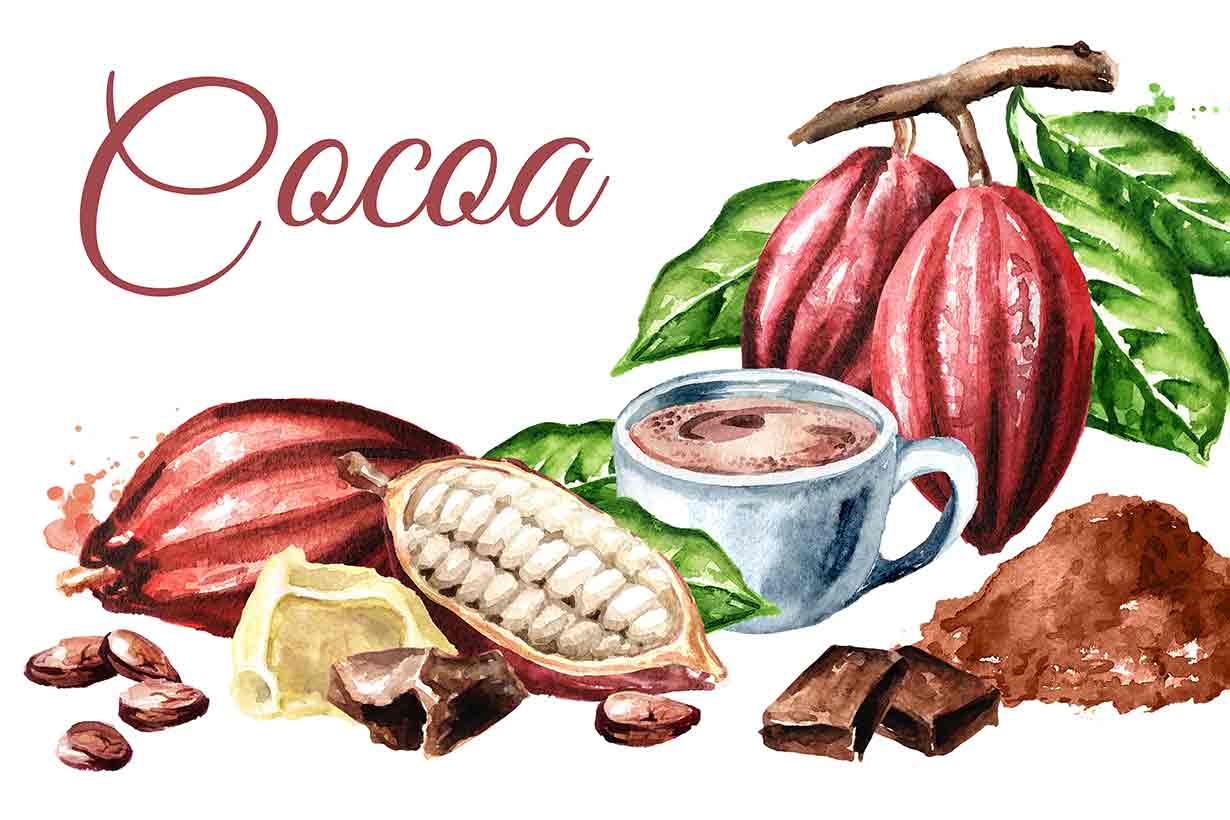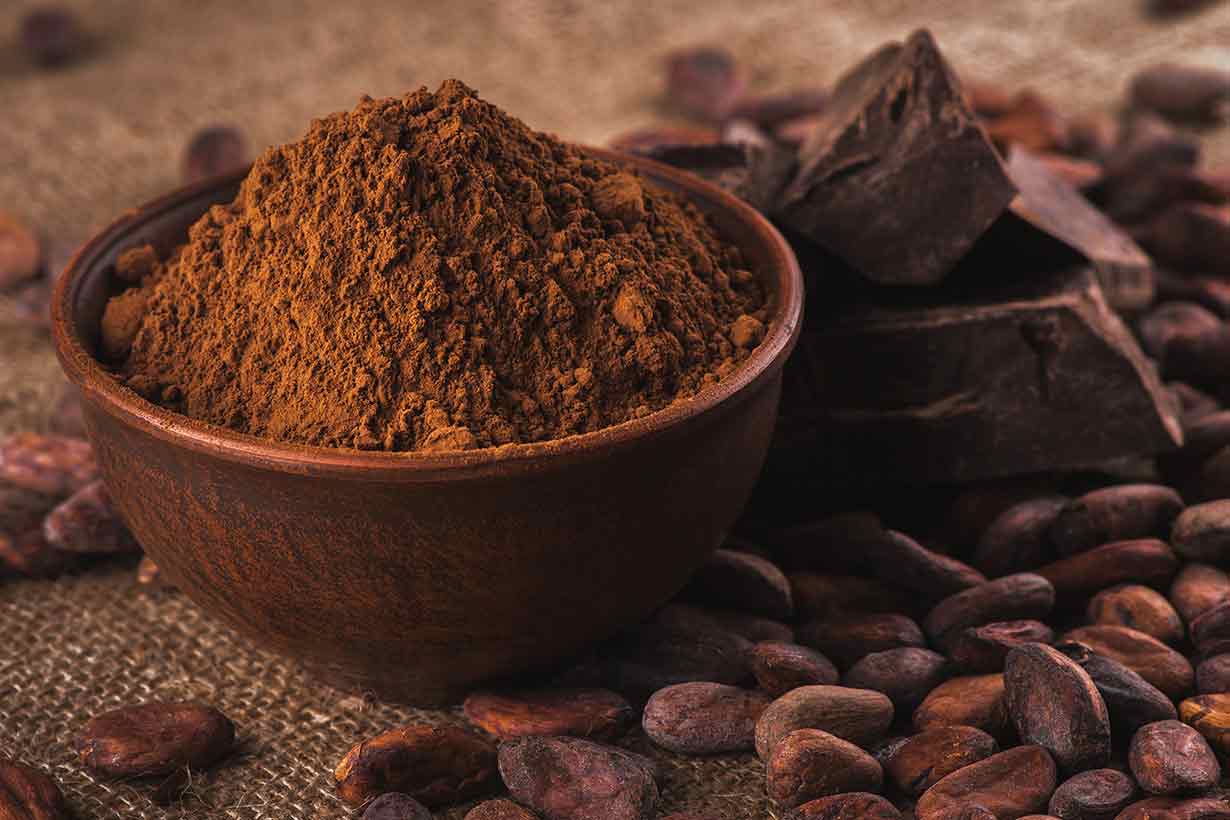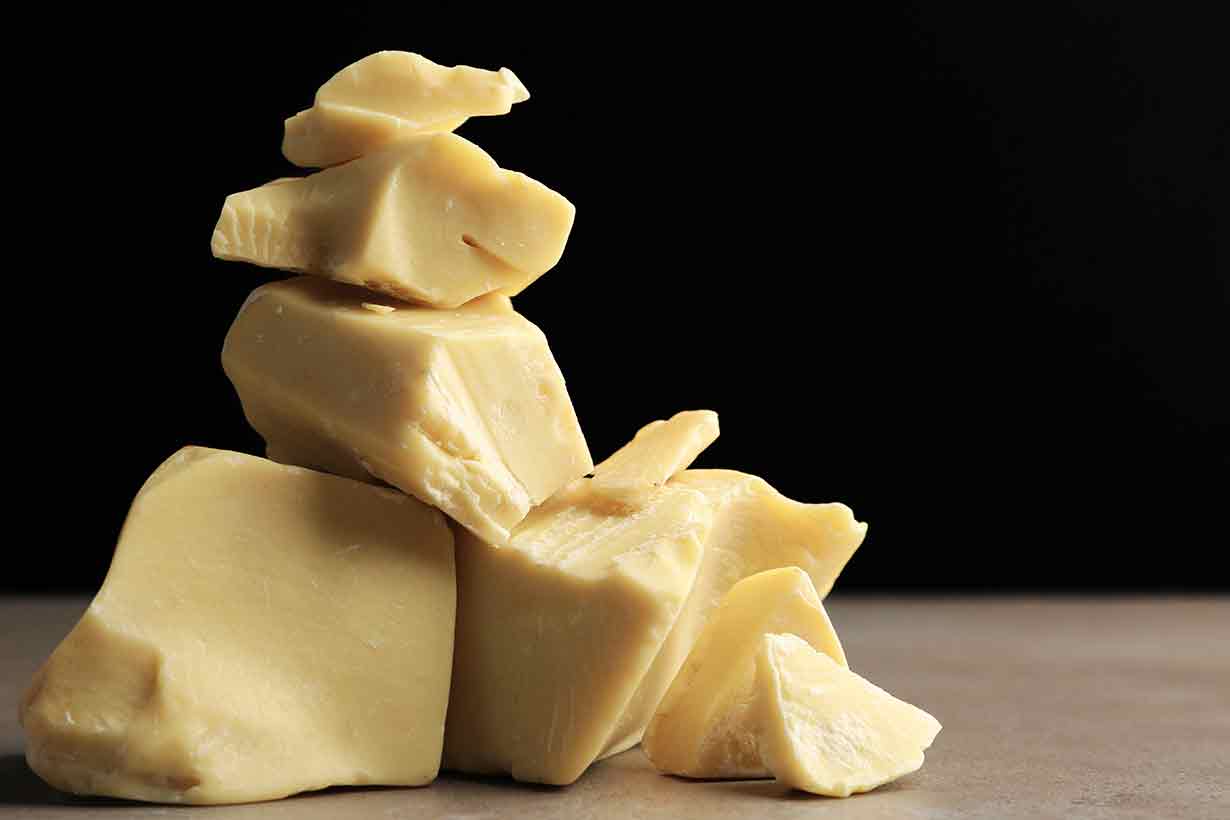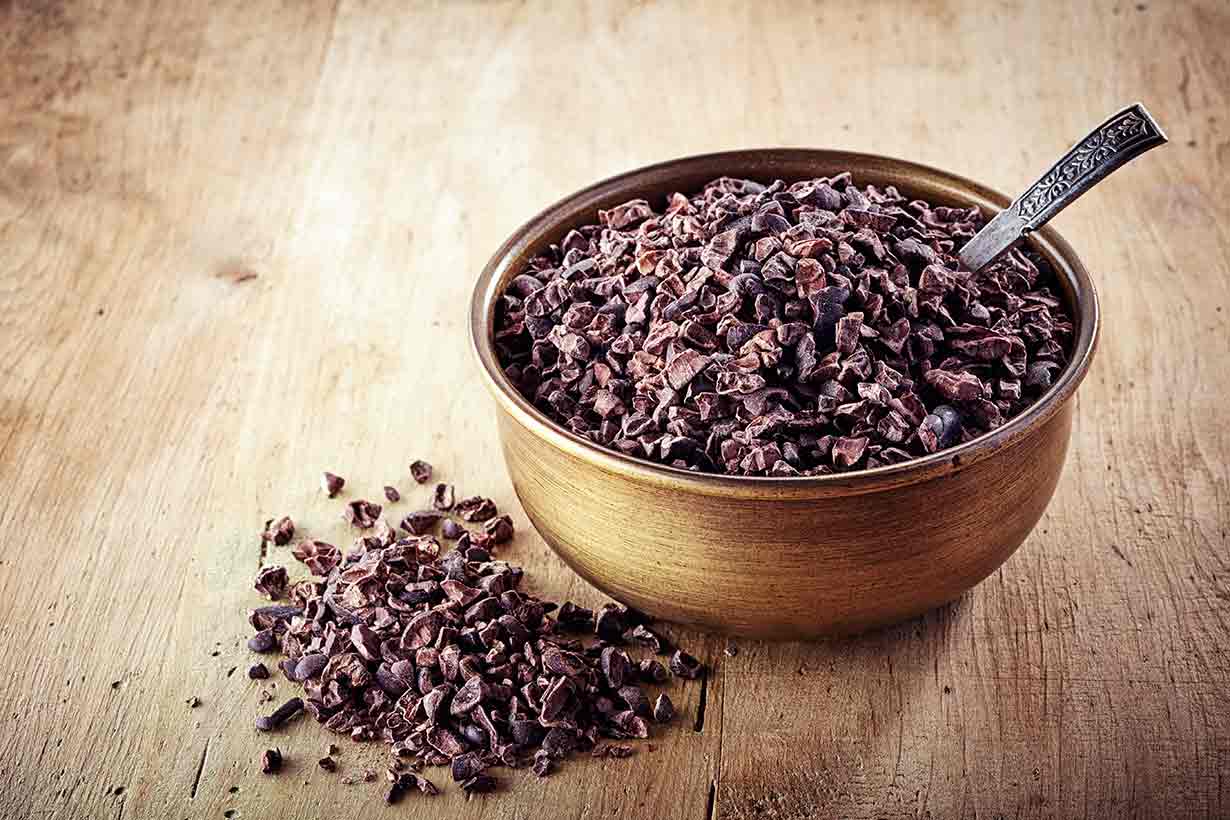When it comes to cocoa products, we hear a lot about dark and milk chocolate, but not so much about white chocolate.
For anyone wondering about the health and nutritional properties of white chocolate, this article will provide an in-depth guide.
We’ll start by examining its typical ingredients profile and the nutrients it contains, followed by assessing its potential benefits and drawbacks. We’ll then review published scientific studies related to white chocolate.
Quick Facts: White Chocolate
- High in fat and sugar: White chocolate is primarily a source of fat and sugar; its fat content may come from cocoa butter alone or a mixture of cocoa butter and vegetable oils, depending on the bar.
- No cocoa solids: White chocolate doesn’t contain cocoa solids (also known as cocoa mass or liquor). Most of dark chocolate’s purported benefits relate to its cocoa solid content.
- Nutritional composition: A typical white chocolate bar contains approximately 532 calories, 32.1 grams of fat, and 59 grams of sugar per 100 grams. Source: USDA data.
Important Note: The content in this article is for informational and educational purposes only. It should not replace medical advice from your healthcare provider.
Table of contents
Typical Ingredients
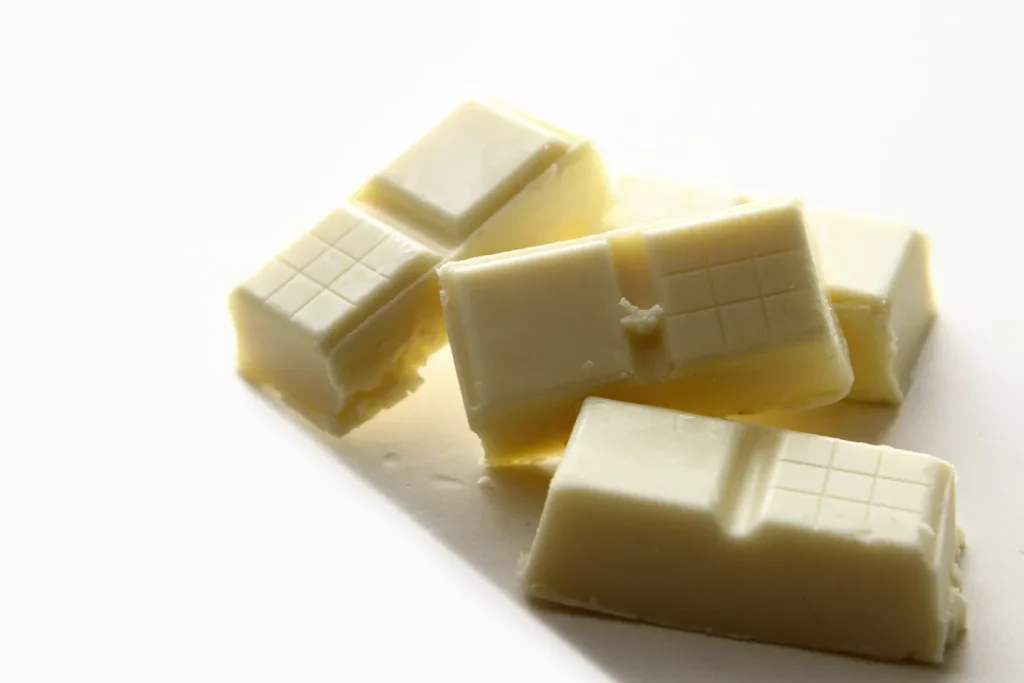
The ingredients you’ll find in white chocolate will depend on the specific bar. While some white chocolate products use only cocoa butter as a fat source, some bars add vegetable oils to the mix since they’re a cheaper alternative.
However, in the United States, any white chocolate product must comply with the ‘standard of identity for white chocolate’ established by the FDA (1).
This standard of identity relates to white chocolate’s composition, and it must contain (1):
- At least 20% cocoa butter by weight
- More than 14% total milk solids
- 3.5% or more milkfat
- A maximum of 55% of added nutritive sweeteners: added sugar, for example.
For example, you may have noticed the famous ‘cookies ‘n’ creme’ bar made by Hershey’s is sometimes described as “white creme” (2). This is because the bar contains no cocoa butter, so it cannot be marketed as white chocolate due to the FDA’s standard of identity.
So, what does the typical ingredients profile of real white chocolate look like? For your convenience, you can see the ingredients profile of four popular branded white chocolate bars in the table below (3, 4, 5, 6):
| Name | Brand owner | Ingredients profile |
|---|---|---|
| Gloriously creamy white chocolate | Divine | Sugar, cocoa butter, skimmed milk powder, butterfat (milk), sunflower lecithin, vanilla |
| Organic white chocolate, 30% cacao | Green & Blacks | Organic cane sugar, organic cocoa butter, organic milk, organic soy lecithin (an emulsifier), organic vanilla bean, organic vanilla extract |
| Premium baking bar, white chocolate | Ghirardelli | Sugar, cocoa butter, nonfat dry milk, milk fat, soy lecithin, vanilla |
| White chocolate classic | Lindt | Sugar, cocoa butter, milk, skim milk, soy lecithin, vanillin (artificial flavor) |
As the table shows, the primary ingredient across all four bars is sugar, which is then followed by cocoa butter. After this, typical ingredients tend to include milk, soy lecithin, and vanilla flavorings.
Lecithin is a type of fat found in plant foods such as seeds, and it acts as an emulsifier—this means that it helps other ingredients to mix better.
The Nutrients in White Chocolate
Now that we know what white chocolate contains, let’s look at what it provides nutritionally. Is it a good source of any vitamins or minerals? Let’s find out.
Sourced from the USDA’s FoodData Central database, the following tables show the full nutritional values for white chocolate per 100 grams and per typical serving (7). One ounce (28.35 g) values have been calculated from the 100 g USDA data.
Calories and Macronutrients
| Nutrient | Per 100 g (% DV) | Per oz (28.35 g) (% DV) |
|---|---|---|
| Calories | 539 kcal | 153 kcal |
| Carbohydrate | 59.2 g (22%) | 16.78 g (6%) |
| Fiber | 0.2 g (1%) | 0.1 g (1%) |
| Sugars | 59.0 g | 16.73 g |
| Fat | 32.1 g (41%) | 9.10 g (12%) |
| Saturated fat | 19.4 g (97%) | 5.49 g (27%) |
| Monounsaturated fat | 9.1 g | 2.58 g |
| Polyunsaturated fat | 1.01 g | 0.29 g |
| Omega-3 | 0.10 g | 0.03 g |
| Omega-6 | 0.91 g | 0.26 g |
| Cholesterol | 21 mg (7%) | 5.95 g (2%) |
| Protein | 5.87 g (12%) | 1.66 g (3%) |
White chocolate is mainly a source of fat and sugar, with only small amounts of protein and fiber.
Vitamins
| Nutrient | Per 100 g (% DV) | Per oz (28.35 g) (% DV) |
|---|---|---|
| Vitamin A (RAE) | 9 mcg (1%) | 2.55 mcg (<1%) |
| Vitamin C | 0.5 mg (1%) | 0.14 mg (<1%) |
| Vitamin D | 0 mcg (0%) | 0 mcg (0%) |
| Vitamin E | 0 mg (0%) | 0 mg (0%) |
| Vitamin K | 9.1 mcg (8%) | 2.58 mcg (2%) |
| Thiamin (B1) | 0.06 mg (5%) | 0.02 mg (2%) |
| Riboflavin (B2) | 0.28 mg (22%) | 0.08 mg (6%) |
| Niacin (B3) | 0.75 mg (5%) | 0.21 mg (1%) |
| Pantothenic acid (B5) | 0.61 mg (12%) | 0.17 mg (3%) |
| Vitamin B6 | 0.06 mg (4%) | 0.02 mg (1%) |
| Folate (B9) | 7 mcg (2%) | 1.98 mcg (<1%) |
| Vitamin B12 | 0.56 mcg (23%) | 0.16 mcg (7%) |
| Choline | 29.5 mg (5%) | 8.36 mg (2%) |
White chocolate provides only small amounts of essential vitamins. Per ounce, it offers a moderate source of riboflavin and vitamin B12.
Note: While the official USDA nutrition entry for white chocolate shows it contains 0 mg vitamin E, this is likely a mistake. All white chocolate products should contain at least 20% cocoa butter, and cocoa butter is a (small) source of vitamin E (8).
Minerals
| Mineral | Per 100 g (% DV) | Per oz (28.35 g) (% DV) |
|---|---|---|
| Calcium | 199 mg (15%) | 56 mg (4%) |
| Iron | 0.24 mg (1%) | 0.07 mg (<1%) |
| Magnesium | 12 mg (3%) | 3.40 mg (1%) |
| Phosphorus | 176 mg (14%) | 49.90 mg (4%) |
| Potassium | 286 mg (6%) | 81.08 mg (2%) |
| Sodium | 90 mg (4%) | 25.52 mg (1%) |
| Zinc | 0.74 mg (7%) | 0.21 mg (2%) |
| Copper | 0.06 mg (7%) | 0.02 mg (2%) |
| Manganese | 0.01 mg (<1%) | 0.002 mg (<1%) |
| Selenium | 4.5 mcg (8%) | 1.28 mcg (2%) |
White chocolate does not offer high amounts of any essential mineral. However, an ounce serving will provide a small amount of calcium and phosphorus due to milk powder being among its ingredients.
Does White Chocolate Have Any Benefits?
Aside from the small amount of essential vitamins and minerals white chocolate contains, does it have any benefits?
In this section, we’ll take a look at potentially beneficial properties of white chocolate.
Cocoa Butter
Cocoa butter is the primary—or sometimes only—fat source in white chocolate. It is an expensive ingredient, but does it have any health effects worth knowing about?
Fatty acid Profile
First, cocoa butter is very high in saturated fat, being approximately 60% saturated fat by weight (8).
Public health advice recommends limiting saturated fat intake to around 10% of total calories or less, and the FDA has set a daily value of 20 grams per day (9, 10, 11). The reason for this is because saturated fat can raise levels of LDL-C (low density lipoprotein cholesterol), which you may have heard referred to as “bad cholesterol” (12, 13).
A wide range of large, high-quality studies have demonstrated elevated LDL-C levels are a causal risk factor for cardiovascular disease (14, 15).
However, an interesting thing that we should note is that there are many different types of saturated fatty acids. Furthermore, not all of them have the same effect. On this note, the primary saturated fat found in cocoa butter is called stearic acid, representing around 33% of the total fat content (8).
Why Is Stearic Acid Different To Other Saturated Fatty Acids?
In the body, stearic acid is partially converted to oleic acid—the main fat in olive oil (16). Additionally, studies show that it does not raise LDL-C levels in the same way as other saturated fats:
- A 2022 systematic review of randomized controlled trials found that replacing stearic acid with unsaturated fatty acids had no beneficial effect on cardiometabolic disease risk markers (17). This effect was in contrast to that of replacing other saturated fatty acids, such as palmitic acid.
- This follows a 2020 systematic review that demonstrated replacing palmitic acid with stearic acid lowered LDL-C levels, despite both fats being “saturated” (18).
Other Fatty Acids In Cocoa Butter
In addition to stearic acid, cocoa butter is also high in the monounsaturated fat oleic acid, which is about 33% of cocoa butter’s fat content (8).
However, cocoa butter does also contains palmitic acid at 25% of total fat, and this is a saturated fatty acid that typically does raise LDL-C (19, 20).
Given its overall fatty acid ratio, cocoa butter may lower LDL-C compared to other saturated fat sources, such as butter or palm oil. However, it may raise it compared to foods like nuts, seeds, and vegetable oils (21).
As with many things in nutrition: it’s nuanced, and it depends on what the cocoa butter would be replacing in the diet.
But remember: some white chocolate products may also contain highly saturated fats—such as palm oil—in addition to cocoa butter. These ingredients are more strongly associated with raising LDL-C (22, 23).
The Drawbacks of White Chocolate
The main drawbacks of white chocolate relate to it being high in fat, sugar, and total calories.
High In Sugar
With a typical sugar content of approximately 59%, sugar is the majority ingredient in a bar of white chocolate.
The 2020-2025 Dietary Guidelines for Americans recommend limiting added sugar in the diet to a maximum of 10% of total calories (24). Based on a 2,000 calorie diet, this is approximately 50 grams of added sugar per day—one gram of carbohydrates like sugar is roughly 4 calories (25).
Public health advice on limiting sugar intake exists due to links between high intake of added sugars and potentially adverse health outcomes.
For example, a 2023 umbrella review of systematic reviews and meta-analyses of randomized controlled trials, as well as large observational studies, examined the impact of sugar intake on human health. The results found that high sugar intake is “generally more harmful than beneficial” for health. Additionally, high dietary sugar intake was associated with body weight changes, heart disease, and childhood obesity (26).
An ounce (28.35 g) serving of white chocolate provides approximately 16.7 grams of sugar (7).
High In Fat and Overall Calories
White chocolate has a high fat content, with most of its fat coming from cocoa butter.
As discussed earlier, cocoa butter can have varying health effects that mainly depend on what it is substituting in the diet. However, all fats are high in calories, and mixing them with sugar is an easy way to get a lot of calories in a small amount of food.
In this context, just an ounce (28.35 g) of white chocolate provides approximately 9 grams of fat and 153 calories (7).
While this amount is generally considered to be a ‘serving size,’ some people may consume much higher amounts of chocolate. A recent 2025 study supports this, demonstrating that the unit size of a chocolate bar significantly affects how much we eat (27).
In other words, white chocolate can add a significant number of calories to the diet, particularly if not sticking to the recommended serving size. Depending on the overall dietary pattern, frequent intake of white chocolate may negatively impact weight management efforts.
Do Studies On White Chocolate Show Any Benefits?
There have been several recent studies on the health effects of white chocolate.
However, these studies tend to be comparisons between dark and white chocolate to tease out findings on the potential benefits of dark chocolate. This is because the two products both contain sugar and cocoa butter, but dark chocolate also contains polyphenol-rich cocoa solids—also known as cocoa mass or cocoa liquor.
Here is a brief summary of three recent studies:
- A 2025 randomized controlled trial involving 17 healthy adults found that dark chocolate slightly improved blood flow in the kidneys compared to white chocolate (28).
- A 2025 study demonstrated that dark chocolate intake improved the gut microbiota (the presence of beneficial bacteria) in mice, while white chocolate did not. This could be attributed to the fiber and phytonutrient content of cocoa, which white chocolate does not contain (29).
- Linking to the mouse study, a 2025 randomized controlled trial involving 40 women found that 25 grams of dark chocolate increased the presence of beneficial gut bacteria while improving symptoms of constipation. However, 25 grams of white chocolate did not have this effect (30).
As shown, the studies involving white chocolate are more about using it as a control to measure the effects of dark chocolate.
Summary: Can White Chocolate Be a Healthy Choice?
As we’ve looked at in this article, white chocolate is generally low in vitamins and minerals and doesn’t appear to have any evidenced health benefits.
With this—and white chocolate’s high sugar and fat content—in mind, it’s difficult to give white chocolate a “healthy” tag. Instead, it is something that we should probably limit our intake of.
That said, white chocolate can fit into an overall healthy dietary pattern if consumed in moderation. By this, I mean an occasional serving of white chocolate as part of an otherwise diet full of nutrient-rich foods.
One potential problem here is the tendency people have to overconsume food products like white chocolate. If you fall into this category, here are some tips that can potentially help:
- Sitting down with a large bar of white chocolate when feeling hungry is unlikely to end well. Instead, it is better to consume a small amount after a meal when already feeling satisfied.
- Combine a piece or two of white chocolate with nutrient-rich foods like fruit, cheese, and nuts.
- Buy a small bar of white chocolate rather than a large bar—as we saw earlier, the unit size of chocolate bars can encourage overconsumption.
Lastly, in terms of potential benefits, dark chocolate is a better option than white chocolate due to its higher provision of fiber, phytonutrients, vitamins, and minerals. But remember, it also contains high levels of fat, sugar, and calories just like white chocolate.




